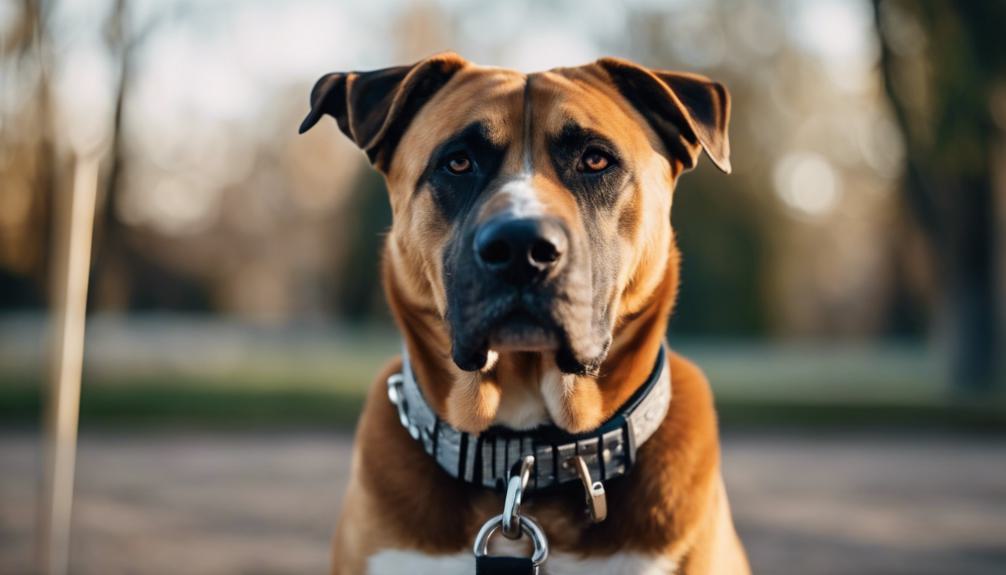How to Train a Bully Dog? Bully Breed Training Tactics
To train a bully dog effectively, start early to establish boundaries and positive habits. Use positive reinforcement like treats and praise, beginning training in puppyhood for obedience. Set clear expectations to help your dog understand what’s required. Consistent training times daily strengthen your bond. Implement commands like ‘sit,’ ‘stay,’ and ‘come’ consistently to avoid confusion. Socialize positively with other dogs and people early to build confidence. Clicker training reinforces good behavior while shaping and capturing techniques help in training advanced tricks. Handle aggression by identifying triggers and seeking professional guidance. These tactics will help mold a well-behaved companion.
Early Training Essentials
To set your Bully breed dog up for success, begin training early to establish clear boundaries and positive habits effectively. Dog training plays an important role in shaping your pet’s behavior, and positive reinforcement techniques such as treats and praise are essential motivators for your Bully.
By using rewards and encouragement from the puppy stage, you can instill good behavior and obedience in your American Bully. Setting clear expectations early on helps your dog understand what’s expected of them, leading to a well-behaved companion.
Consistent training sessions at the same time daily are beneficial for bully breeds, as routine training not only reinforces good habits but also strengthens the bond between you and your furry friend.
Consistent Commands for Bully Dogs
Implementing consistent commands is essential for effectively training bully breed dogs. By using the same cues like ‘sit,’ ‘stay,’ and ‘come’ consistently, you can avoid confusion and reinforce learning in your bully dog. Repetition of commands in various environments helps your furry friend generalize the behavior, ensuring they respond reliably in different situations. Consistency in commands not only builds trust and comprehension between you and your bully breed dog but also provides structure and guidance during training sessions. Remember to praise your dog when they follow commands correctly, as positive reinforcement is a powerful tool in training. Check out the table below for a quick reference on the importance of consistent commands during training sessions.
| Importance of Consistent Commands |
|---|
| Helps avoid confusion |
| Reinforces learning |
| Generalizes behavior |
| Builds trust and comprehension |
Positive Reinforcement Techniques
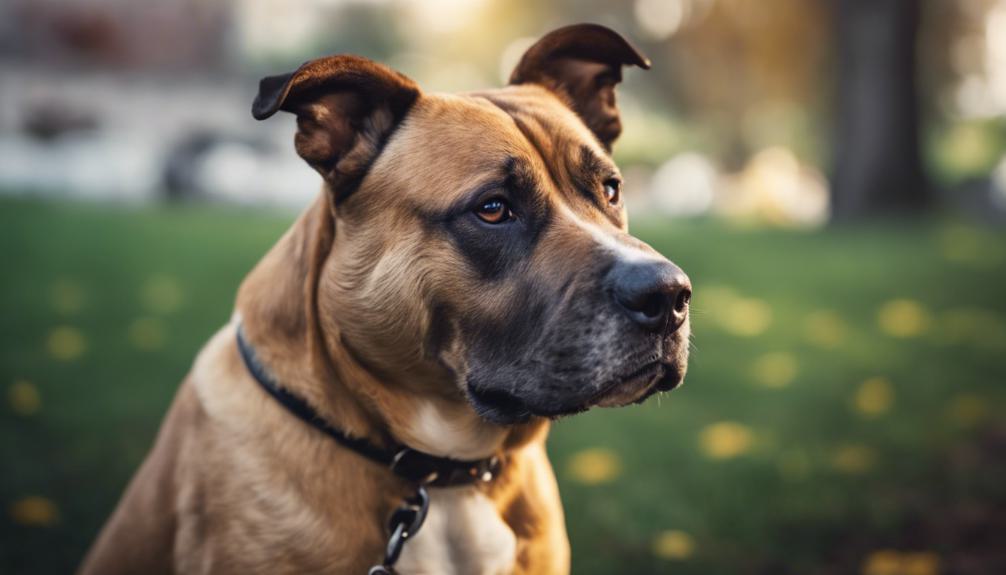
When training bully breed dogs, utilizing positive reinforcement techniques such as rewarding good behavior with treats or praise is key for motivating desired actions. Positive reinforcement involves providing your dog with rewards like treats, verbal praise, or affection when they exhibit behaviors you want to encourage, such as a good stay.
Consistent use of positive reinforcement not only helps in training but also strengthens the bond between you and your dog, leading to better outcomes. By pairing clear communication through consistent commands with rewards, bully breed dogs can quickly understand what’s expected of them.
Creating a positive learning environment with treats and praise during training sessions encourages good behaviors and motivates your dog to continue displaying them in the future. So, train your dog with positivity to see great results!
Socialization Strategies for Bully Breeds
To guarantee your bully breed becomes a well-rounded and socialized companion, early positive experiences and controlled exposure to other dogs and people are key.
By introducing your dog to a variety of environments and situations in a positive and supervised manner, you can help them develop proper social skills and confidence.
These strategies can pave the way for a well-adjusted and friendly bully breed that can navigate social interactions with ease.
Early Positive Experiences
Early positive experiences play a pivotal role in shaping the social behaviors and interactions of bully breed dogs like American Bullies. Introducing your Bully to various environments, people, and other dogs during the critical puppy stage is essential for preventing fear and aggression issues later on. Positive socialization experiences help mold your Bully’s temperament and social skills, setting the foundation for well-behaved behavior. Supervised playtime with other well-behaved dogs can teach your Bully appropriate social cues and behaviors. Addressing any signs of aggression early and managing triggers play an important role in preventing behavior problems in bully breeds.
| Socialization Strategies | Description |
|---|---|
| Various Environments | Expose your Bully to different places and settings. |
| Interaction with People | Encourage positive interactions with various individuals. |
| Playtime with Other Dogs | Supervised sessions help in learning social cues. |
| Handling New Experiences | Introduce novel situations to build confidence. |
| Positive Reinforcement | Reward good behavior to reinforce positive traits. |
Controlled Exposure to Others
Build your Bully breed’s confidence and social skills through controlled exposure to other well-behaved dogs and supervised interactions, guaranteeing positive socialization experiences. Here are some strategies to help you with this process:
- Start Early: Begin socializing your Bully breed as soon as possible to prevent fear or aggression towards others.
- Supervised Interactions: Monitor your Bully’s interactions with other dogs closely to make sure they’re positive and well-behaved.
- Introduction to Various Environments: Expose your Bully to different settings, sounds, and experiences to boost their confidence and reduce anxiety.
- Address Aggression Promptly: If you notice any signs of aggression, seek professional help promptly to maintain a safe socialization journey for your Bully breed.
Clicker Training Basics
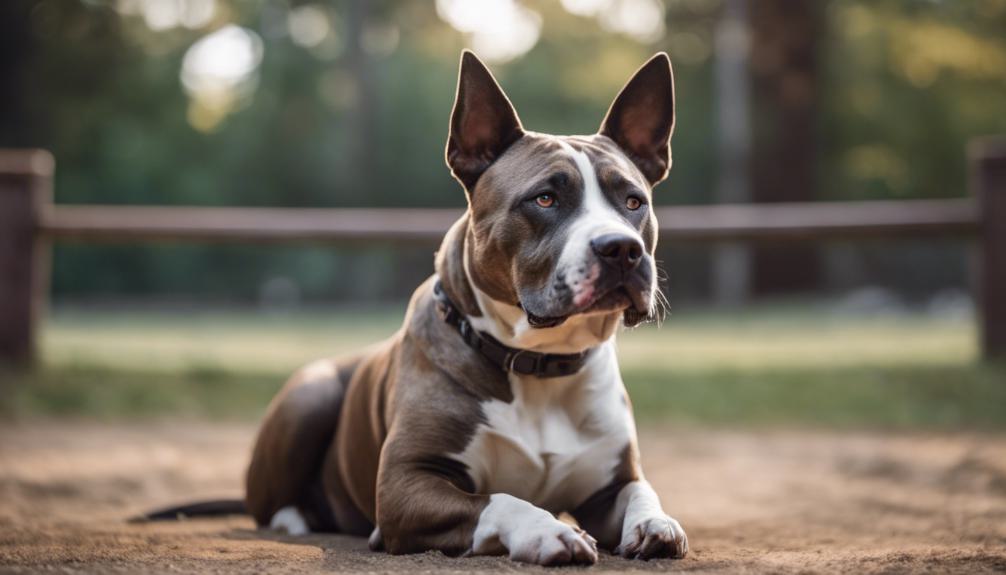
Using a clicker device is an effective way to reinforce desired behaviors in bully breed dogs during training sessions. Clicker training involves marking positive actions with a clicking sound, followed by a treat, which reinforces good behavior. This method is based on positive reinforcement, where the dog associates the click with a reward, helping them understand commands more effectively.
By consistently practicing with the clicker, you can shape your bully breed dog’s behavior and improve communication during training. The engagement and focus promoted by clicker training not only enhance the learning process but also strengthen the bond between you and your dog.
Embrace this technique to create a positive and rewarding training experience for both you and your bully breed companion.
Behavior Modification Tactics
To effectively modify behaviors in bully breed dogs, focus on utilizing positive reinforcement techniques to encourage desired behaviors and discourage negative ones. Consistency is key in this process to effectively communicate expectations to your bully.
Here are some strategies to help you tackle behavior modification with your bully breed:
- Reward Good Behavior: Use treats, praise, or toys to reinforce positive actions.
- Ignore Unwanted Behavior: Withhold attention or rewards when your bully displays negative behaviors.
- Establish Clear Rules: Set boundaries and stick to them consistently to avoid confusion.
- Training Exercises: Implement specific exercises that target and address the behavioral issues you want to modify.
Mental Stimulation Activities
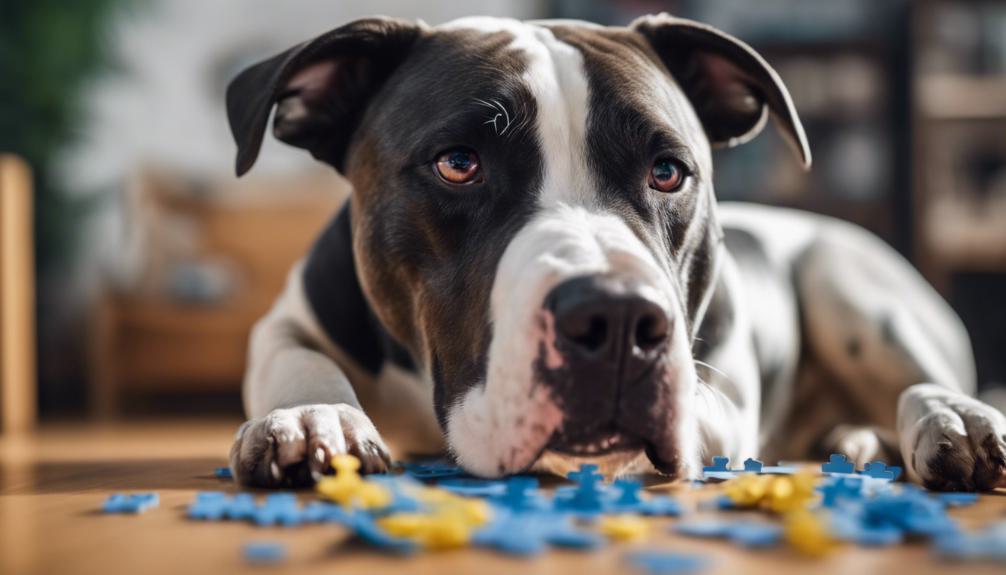
Engage your bully breed dog in mental stimulation activities to keep them engaged and prevent boredom. Interactive puzzle toys are great for challenging their problem-solving skills.
Reward your dog during play sessions with these toys to reinforce positive behavior. Additionally, incorporate scent work games by hiding treats around the house to stimulate their sense of smell and provide a fun challenge.
Teaching your dog new tricks regularly is another effective way to keep their minds active and sharp. Rotate toys and activities to prevent monotony and maintain their interest in mental stimulation exercises.
Advanced Training Methods
Advanced training methods for refining your bully breed’s skills include implementing shaping and capturing techniques to enhance their abilities.
Shaping involves rewarding incremental steps towards a desired behavior, gradually building complexity. On the other hand, capturing focuses on rewarding your dog’s natural behaviors that align with the training goal, reinforcing positive actions as they occur.
To further improve focus and precision, incorporate targeting exercises into your training routine. Additionally, challenge your bully breed with advanced tricks and agility training to provide mental stimulation and keep them engaged.
Handling Aggression in Bully Dogs
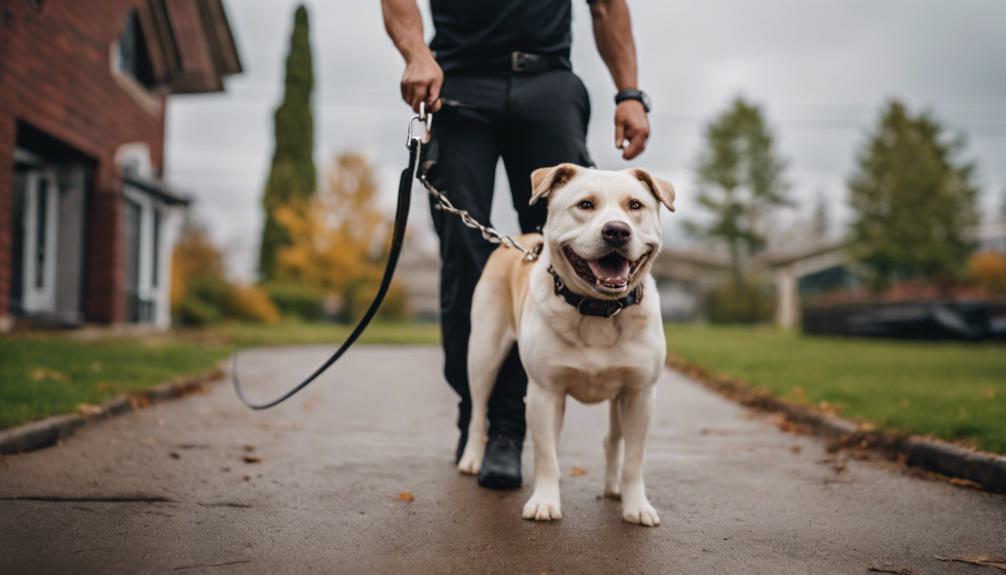
When addressing aggression in Bully dogs, it’s important to be vigilant in identifying triggers and signs of aggression to effectively manage their behavior.
Utilizing positive reinforcement techniques can help redirect aggressive tendencies and promote more desirable behaviors in your Bully breed.
If aggression persists, seeking guidance from a certified dog trainer or behaviorist is vital to guarantee the safety and well-being of both your pet and those around them.
Aggression Triggers in Dogs
Recognizing the different triggers of aggression in dogs, especially in bully breeds, is essential for effectively managing and addressing aggressive behavior in these dogs. Having insight into your bully dog’s body language and signs of aggression is vital for early intervention. Here are some common aggression triggers in dogs:
- Fear: Dogs may become aggressive when they feel threatened or scared.
- Resource guarding: Protecting valuable resources like food or toys can lead to aggressive behavior.
- Territorial behavior: Dogs may exhibit aggression to protect their perceived territory.
- Pain or discomfort: Physical discomfort or illness can sometimes manifest as aggression in dogs.
Calming Techniques for Aggression
To effectively manage aggression in bully breed dogs, implement desensitization techniques to help your dog remain calm in triggering situations.
Gradual exposure to the aggression triggers during training sessions can help your dog learn to stay composed when faced with challenging circumstances. Counter-conditioning methods can also be beneficial in changing your dog’s negative associations with aggression triggers.
Positive reinforcement training encourages your dog to display good behavior and reinforces calm responses. It’s important to create a safe and controlled environment to manage and prevent aggressive episodes effectively.
Seeking professional help from a certified dog trainer or behaviorist experienced in handling aggression in bully breeds can provide additional support and guidance in addressing your dog’s aggression issues.
Professional Aggression Training
Identify the professional aggression training methods best suited for handling aggression in bully breed dogs. When seeking professional help to address aggression in your bully dog, look for a certified dog trainer or behaviorist with experience in handling aggression specific to bully breeds. Here are four key tactics used in professional aggression training:
- Behavioral Assessment: Professionals will conduct a thorough assessment to understand the root cause of your dog’s aggression, whether it stems from fear, territorial behavior, or lack of socialization.
- Desensitization Techniques: Implement desensitization methods to gradually expose your dog to triggers that provoke aggression, helping them learn to remain calm in those situations.
- Counterconditioning: Use counterconditioning techniques to replace aggressive responses with positive behaviors through consistent reinforcement.
- Positive Reinforcement: Encourage and reward desirable behaviors to redirect aggression towards more acceptable actions, reinforcing good behavior in your bully dog.
Frequently Asked Questions
What Are the Secrets of Training a Bully Breed?
To train a bully breed, use positive reinforcement like treats and praise, establish a consistent training routine, and communicate clearly with commands and gestures. This approach fosters a strong bond and motivates desired behaviors in your dog.
What Is the Best Training for American Bullies?
Consistent training with positive reinforcement like treats and verbal praise at the same time daily helps American Bullies understand expectations. Early training from the puppy stage establishes good habits. Clear communication through commands and gestures aids comprehension.
Are Bullies Hard to Train?
Bullies can be challenging to train due to their stubbornness and independence. Consistent methods and positive leadership are essential. Grasping their breed traits and adapting training techniques can make the process more successful.
What Are the Best Activities for Bully Breeds?
Engage in structured obedience classes, agility courses, and interactive games to challenge your bully breed. Explore weight pulling to build strength positively. Try nose work to stimulate natural instincts. Tailor activities to your dog’s needs.
Conclusion
To sum up, training a bully dog requires consistency, patience, and positive reinforcement.
By starting with early training essentials, using consistent commands, and incorporating socialization strategies, you can help your bully breed become a well-behaved and happy companion.
Remember to provide mental stimulation, utilize behavior modification tactics, and handle aggression with care.
With dedication and the right training techniques, you can build a strong bond with your bully dog and set them up for success.

